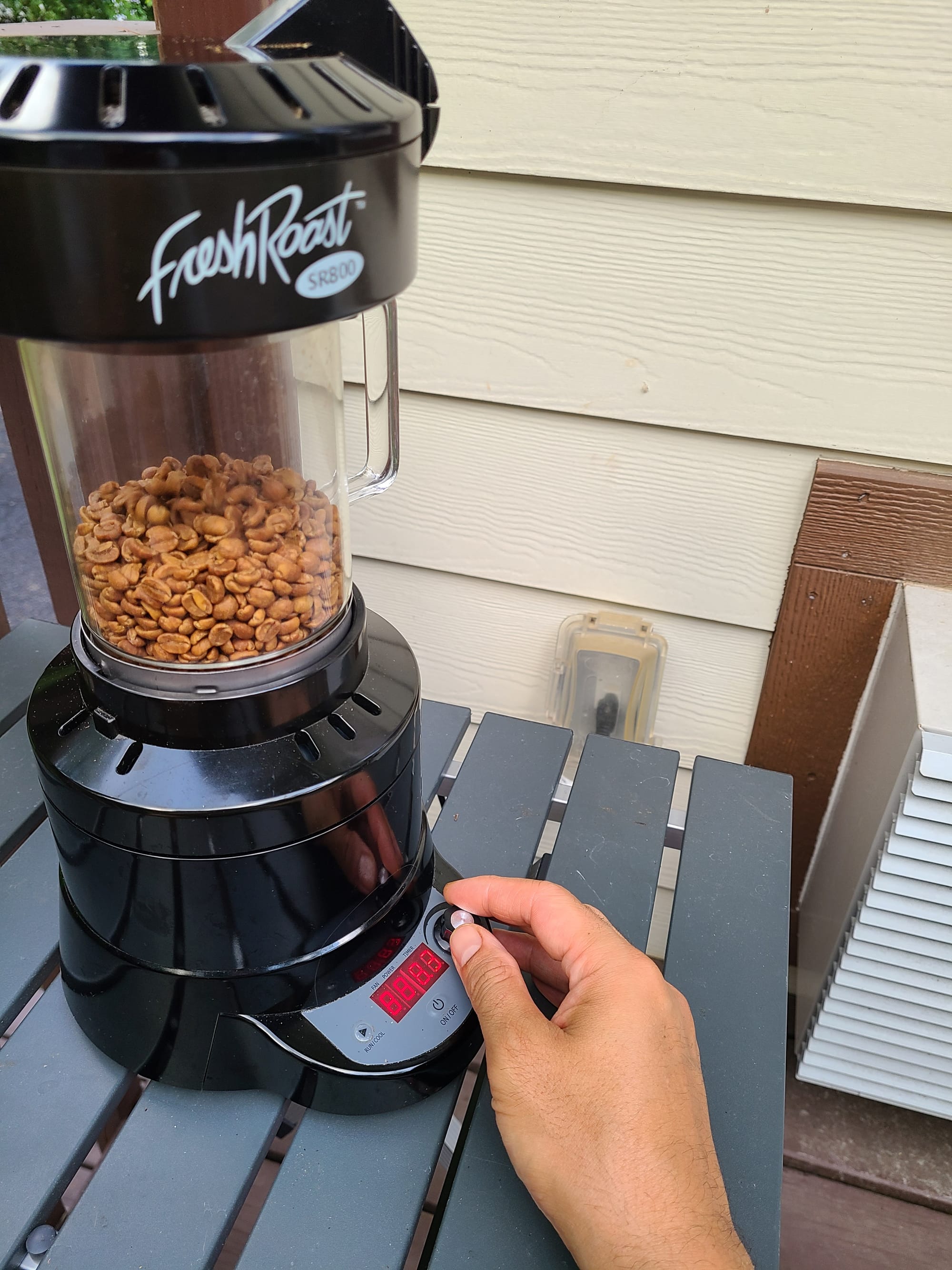Roasting Coffee at Home: a Beginner's Guide to Get Started
Once you’ve had freshly roasted coffee that froths as the hot water hits it, you realize how good coffee could really be. This guide will introduce you to the world of home coffee roasting.

Greeting the morning while the dew clings to branches and windshields and watching the sun rise and burn off the morning fog is divine when your hands are wrapped around a warm cup of good coffee.
At least, that’s what coffee commercials used to show when I was growing up. (That and many noses, sniffing the air like hounds).
Less divine is bad coffee. And most coffee we drink is bad coffee because it’s stale. (How much foam bubbles as you brew it is a good check).
Once you’ve had freshly roasted coffee that froths as the hot water hits it, you realize how rich, how different, how good coffee could really be. And there's no going back. You start by hitting your local coffee shops that also roast, but soon enough, there will come a time when you dare to learn to roast coffee for yourself. This guide will introduce you to the world of home coffee roasting.
1. Why Roast Your Own Coffee?
Unparalleled freshness. Sipping coffee made from beans you've roasted yourself is a revelation – it's like plucking a garden-fresh tomato compared to a plastic-bagged supermarket one. For me, I moved to a place in rural Iowa where there was no locally roasted coffee, which is to say, no fresh coffee. And since it was the pandemic, I had to learn to roast for myself.
Beyond flavor, roasting your own beans can be cheaper. While there's an initial investment in equipment, green coffee beans are significantly cheaper than roasted ones you get in the supermarket, especially premium beans.
Also, as the roaster, you control the flavor profile: Want a dark, chocolatey roast? Go for it. Prefer a light city roast? You can do it all from the same bag of the same green coffee beans. You ensure quality control – you know exactly what's in your cup, from the bean origin to roast level.
2. Understanding Coffee Beans
Coffee can taste chocolatey, spicy, fruity, buttery and more. Much of the flavors influenced by their origin. Ethiopian beans often are full-bodied and fruity, while Indonesian varieties offer chocolatey tastes. (And of course the particular micro climates and soil change changes the flavor as well). The two main species, Arabica and Robusta, differ significantly. Arabica is smoother and more complex, while Robusta is stronger and more caffeinated.
Bean size and density affect roasting. Larger beans generally need more heat to roast evenly, while denser beans can withstand higher temperatures. When sourcing green (unroasted) beans, quality is paramount. Specialty coffee suppliers and local roasters are excellent sources for high-quality beans.
There are a lot of places to get dried unroasted coffee. Here are three good spots:
3. Essential Equipment for Home Roasting
You don't need expensive equipment to start roasting: a heavy-bottomed skillet and wooden spoon can suffice for beginners. For a step up, consider a popcorn popper – an affordable and effective option for small batches (100g). (In fact, St. Maria’s, a coffee bean supplier, sells a modified one they call the “Poppo”).

Dedicated home roasting machines offer more control and consistency but cost more, from simple skillets with moving arms to expensive drum roasters. It really comes down to how much you want to spend, and how much control over your roast you want (and are ready for).
I started out with a Cafemasey nut and bean roaster like this. One of the first lessons I learned was that roasting coffee smokes a lot (meaning that you’ll usually need to roast outside or in a very well-ventilated space) and that you need a couple of metal colanders to cool and rid the chaff. (Simply by pouring the hot beans from a height from one colander to the other and letting the breeze take the chaff off the beans). Also, make sure to keep a fire extinguisher around.

I moved on to a SR800 from Home Roasting Supplies which takes care of most of the chaff and gives incredible control allowing me to practice different kinds of roast (from lighter city roasts with more caffeine to darker Vienna roasts where you can see the beans sweating oil).

4. The Science Behind Coffee Roasting
Roasting transforms green coffee beans through a series of chemical reactions. The most significant is the Maillard reaction, responsible for creating hundreds of flavor and aroma compounds. As beans roast, they change color from green to yellow, then various shades of brown.
Two key events during roasting are the "first crack" and "second crack." The first crack, sounding a bit like popcorn popping, marks the beginning of light roasts. Often, at this stage, the coffee has a brighter taste or more of a sour taste than after the second crack, which is more subtle and indicates the start of dark roasts. After the second crack, the taste is more chocolatey but potentially more burnt-tasting coffee. Each roast level brings out different characteristics in the bean, affecting flavors, acidity, and body.
5. Step-by-Step Guide to Your First Roast
1. Set up in a well-ventilated area with your equipment ready. I found it simplest to just set out a little camping table outside with a chair and roast outside.
2. Start with a small batch of green beans. (About 227g for the SR800 roaster, which I found perfect to supply a little less than a week’s worth of coffee, yet not so much that I’d feel guilty if I screwed it up.)
3. Look at the instructions of whatever device you got to roast. (Seriously). If you’re doing it on a pan in your kitchen (a recipe to set off fire alarms in my opinion), Preheat your roasting device and add the beans.
4. Monitor the color change from green/whitish to yellow and then to brown. Listen for the cracks. Pay attention. What’s happening to the beans color? What are you smelling? Listen for the first crack.
5. Keep moving the beans with a wooden spoon if you’re using a skillet. This helps you to make an even roast if you’re not using a device that will do it for you.
6. Roast until you get the right colored roast. (More of a city roast? Then stop soon after most of the beans have given you the first crack. For darker roast, wait until after the second crack), cool the beans quickly. (I usually use a pair of colanders outside on the lawn and pour the beans from one to the other.)
7. Allow the beans to degas for 12-24 hours before sealing and storing. If you make coffee, like in a French press, look at the difference in the foam released by freshly roasted coffee.
Each roast is a learning experience. My first few were basically burnt. Don't be discouraged if your first attempt isn't magical.
6. Developing Your Roasting Skills
Keep a roasting journal to track your progress and experiments. In your roasting journal, be sure to notate times, temperatures (both of the air and what you roast at) and the humidity. Humidity plays a large role, which I’m only beginning to understand.
Try beans from different regions and play with various roast profiles. Learn cupping techniques to refine your palate, maybe ban together a few friends, or go to a coffee expo (something I did years ago in South Korea which simply blew my mind).
As you advance, explore blending different beans or creating flavored coffees. Remember, roasting is an art: (yes, there’s also tons of science, but when if you roast coffee on a hot summer’s day, or on a cold winter night, I find that I’m following my senses more than the numbers on my roaster, which to me feels mores like an art than a science). And remember to have fun with it!
Conclusion:
Home coffee roasting is really cool because it combines creativity, science, and real attention to your senses. With practice and patience, you'll be crafting coffee that rivals or surpasses your local café. (You may smirk at that as a cheesy cliche, but seriously, when you’re roasting for yourself, you can roast it to your own palette. Chains can’t). So grab some green beans, fire up your roaster, and embark on your aromatic adventure. Happy roasting!